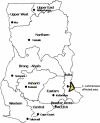An outbreak of suspected cutaneous leishmaniasis in Ghana: lessons learnt and preparation for future outbreaks
- PMID: 21765823
- PMCID: PMC3137292
- DOI: 10.3402/gha.v4i0.5527
An outbreak of suspected cutaneous leishmaniasis in Ghana: lessons learnt and preparation for future outbreaks
Abstract
Human cutaneous leishmaniasis (CL) has previously been reported in West Africa, but more recently, sporadic reports of CL have increased. Leishmania major has been identified from Mauritania, Senegal, Mali, and Burkina Faso. Three zymodemes (MON-26, MON-117, and MON-74, the most frequent) have been found. The geographic range of leishmaniasis is limited by the sand fly vector, its feeding preferences, and its capacity to support internal development of specific species of Leishmania. The risk of acquiring CL has been reported to increase considerably with human activity and epidemics of CL have been associated with deforestation, road construction, wars, or other activities where humans intrude the habitat of the vector. In the Ho Municipality in the Volta Region of Ghana, a localised outbreak of skin ulcers, possibly CL, was noted in 2003 without any such documented activity. This outbreak was consistent with CL as evidenced using various methods including parasite identification, albeit, in a small number of patients with ulcers. This paper reports the outbreak in Ghana. The report does not address a single planned study but rather a compilation of data from a number of ad-hoc investigations in response to the outbreak plus observations and findings made by the authors. It acknowledges that a number of the observations need to be further clarified. What is the detailed epidemiology of the disease? What sparked the epidemic? Can it happen again? What was the causative agent of the disease, L. major or some other Leishmania spp.? What were the main vectors and animal reservoirs? What are the consequences for surveillance of the disease and the prevention of its reoccurrence when the communities see a self-healing disease and may not think it is important?
Keywords: Ghana; Volta Region; West Africa; cutaneous leishmaniasis; follow-up; outbreak.
Figures
References
-
- Lafont A, Heckenroth F. Un cas de leishmaniose canine a Dakar. [A case of canine leishmaniasis in Dakar]. Bulle soc Trop MedBulletin de la Société de Pathologie Exotique. 1915;8:162–4.
-
- Elmes GT, Hall RN. Cutaneous leishmaniasis in Nigeria. Trans R Soc Trop Med Hyg. 1944;37:437–9.
-
- Jelliffe RS. Cutaneous leishmaniasis in Nigeria and the Western Sudan. Wes Afri Med J. 1955;4:92–4. - PubMed
-
- Ranque P. Les leishmanioses au Sénégal (étude épidémiologique et écologique) [Leishmaniasis in Senegal (Epidemiological and ecological studies)]. Trop MedMédecine tropicale. 1978;38:413–7. - PubMed
-
- Dedet JP, Derouin F, Hubert B, Schnur L, Chance ML. Isolation of Leishmania major from Mastomys erythroleucus and Tatera gambiana in Senegal (West Africa) Ann Trop Med Para. 1979;73:433–7. - PubMed
Publication types
MeSH terms
LinkOut - more resources
Full Text Sources
Medical
Miscellaneous




